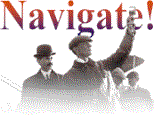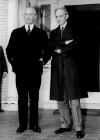|





Meanwhile:
How about a
little music?
We have a selection of tunes that were
popular during the first days of aviation, performed by Sue Keller, courtesy the
Ragtime Press:
Want to ask a question? Tell
us something? Arrange a showing of one of our airplanes? Ping:
mailto:[email protected]
| |
| About
Greenfield Village
Henry Ford Museum and its adjacent Greenfield Village were conceived by
Ford as a learning institution where Americans could learn how their
ancestors lived and worked in the past � specifically Henry Ford's past,
the latter half of the nineteenth century and early portion of the
twentieth. Ford believed that the precepts he had learned growing up in
rural and small town Midwest America was responsible for his success and
that of other Americans such as Thomas Edison, George Washington Carver,
and the Wright Brothers. Thomas Edison himself signed the cornerstone of
"The Edison Institute," as it was originally known, in 1928.
Then Ford began to fill the 8-acre building with what, at the time, many
considered flea market fodder. Today, of course, they are priceless
relics.
Legend has it that Ford set out to buy "one of everything made in
America" from the Edison Institute's target time period and by all
appearances, he very nearly succeeded. In addition to a word-class
collection of historic automobiles, there is also a dazzling array of
bicycles, plows, canning jars, saw mills, electric fans, steam engines,
rocking chairs, early airplanes and other flotsam and jetsam from the Good
Old Days. The present staff has expanded the original time period to
include all of America's past. You will, for example, find a 1952 Oscar
Meyer Weinermobile, a 1960 McDonald's Hamburger marquee, as well as relics
from Colonial America. It is as complete a picture of American culture as has
ever been assembled.
Not content just with artifacts, Ford also collected buildings and
resurrected them in a "village" on an 81-acre tract next to the
museum. Greenfield Village consists of over 80 historic structures that
were built in different parts of the United States at different time
periods, providing life-size snapshots of homespun American architecture
and industry. Originally, the village was intended as a hands-on classroom
where students could learn both old and new technical skills. There's
still a fair amount of hands-on learning that goes on here, but Ford
opened it to the public in 1933.
Some of the buildings in the village are the homes and workshops of the
people who invented modern America � Ford's old Michigan homestead is
there, along with Edison's New Jersey laboratories, and � of course �
the Wright brother's home and bicycle shop.
|
Click on a
photo to enlarge it.

The Wright home (right) and Wright bicycle shop
(left) as they now appear in Greenfield Village.

The Wright home at 7 Hawthorne Street in Dayton,
Ohio as it appear about 1900.

The Wright bicycle shop around 1919.

Orville and Charlie Taylor at work in the shop in
1897.

Wilbur at work in the shop in 1897.

The Webbert Building at 1127 West Third Street,
which house the Wright Cycle Company, was expanded in the 1920s.
|
| Acquiring
the Wright Stuff
Henry Ford became interested in the old Wright Cycle Company at the
urging of William E. Scripps, a Detroit journalist and aviation
enthusiast. Orville was invited to visit Greenfield Village in the summer
of 1936 and five days after his visit, the Wright's old landlord, Charles
Webbert, sold the old shop building at 1127 West Third Street to Ford for
$13,000. Several Dayton residents raised a fuss when the Dayton Daily
News broke the story a few days later. Judge James Douglas of the
Court of Common Pleas wrote, "It is an outrage to let a thing like
this happen. First England takes the first airplane and now Henry Ford
takes the original workshop�" (At the time, the 1903 Wright Flyer
was in the British Science Museum. Orville had sent it there to protest the
Smithsonian's refusal to admit that he and his brother were first to build
a practical airplane.)
Most of Dayton, however, remained as uninterested in the matter as they
had when the Wrights were making their first flights at Kitty Hawk and
Huffman Prairie. Henry Ford, his son Edsel, and Fred Black, the director
of Greenfield Village, swooped down from Dearborn that October. While
talking to Orville about removing the bicycle shop, they found that the
old home at 7 Hawthorne Street might also be available. A month later,
they bought it from Lottie Jones, the Wright's former washerwoman, for
$4,100. By February of 1937, both the shop and the house had been removed
to Michigan. Henry Ford even took the dirt on which the house stood, and
the hole in the ground on Hawthorne Street remained for many years.
|

Orville Wright and Henry Ford meeting at Hawthorne
Hill in 1936.

Orville and Henry inside the old bike shop looking
out on West Third Street.

Henry Ford (right), Charlie Taylor (middle right),
Orville Wright (middle left), and Orville's nephew Wilbur Wright (left),
consult about the restoration of the home and bike shop.
|
| Restoring
the Home and Shop
At Greenfield Village, both the house and the shop were placed side by
side. (In Dayton, they had been a few blocks apart.) Curators restored
them as nearly as possible to their appearance in 1903, when the Wrights
made their first powered flight. Ford's people looked high and low for Charlie Taylor, the
Wright's mechanic and the builder of their first airplane motors. They
finally traced him to California
where he was working as a machinist for North American Aviation for 65
cents and hour. The Edison Institute hired him as a consultant to oversee the restoration
of the shop. Charlie, working with Orville's secretary, Mabel Beck,
tracked down most of the machine tools they had used in the shop. What he
couldn�t find, Charlie made, including the natural gas engine that the
Wrights had built to power their tools.
Orville and Lottie Jones gathered items for the house, including some
pieces of furniture that he and Wilbur had made. For some time, Lottie
kept "discovering" things that had belonged to the Wrights and
sending them up to Greenfield Village with requests for payment. Fred
Black was amenable, but he didn't want her to continue milking the Edison
Institute indefinitely. He finally confronted Lottie and demanded a
complete list of the items she had so he could arrive at a final financial
settlement.
The restored house and bicycle shop opened on Wilbur's birthday, April
16, 1938. Charles Kettering, inventor of the automotive self-starter and a
friend of the Wrights, presided over the ceremony. Several pioneer
aviators, including Frank Lahm and Walter Brookins (both of whom the
Wrights taught to fly), also attended.
|

The restored Wright home and shop in 1938.

The restored interior of the Wright Cycle Company
workshop.

Orville Wright and others guests of honor at the
dedication ceremonies in 1938.

Members of the Wright family that gathered for the
dedication.

Orville on the porch of his restored home.
|
|

